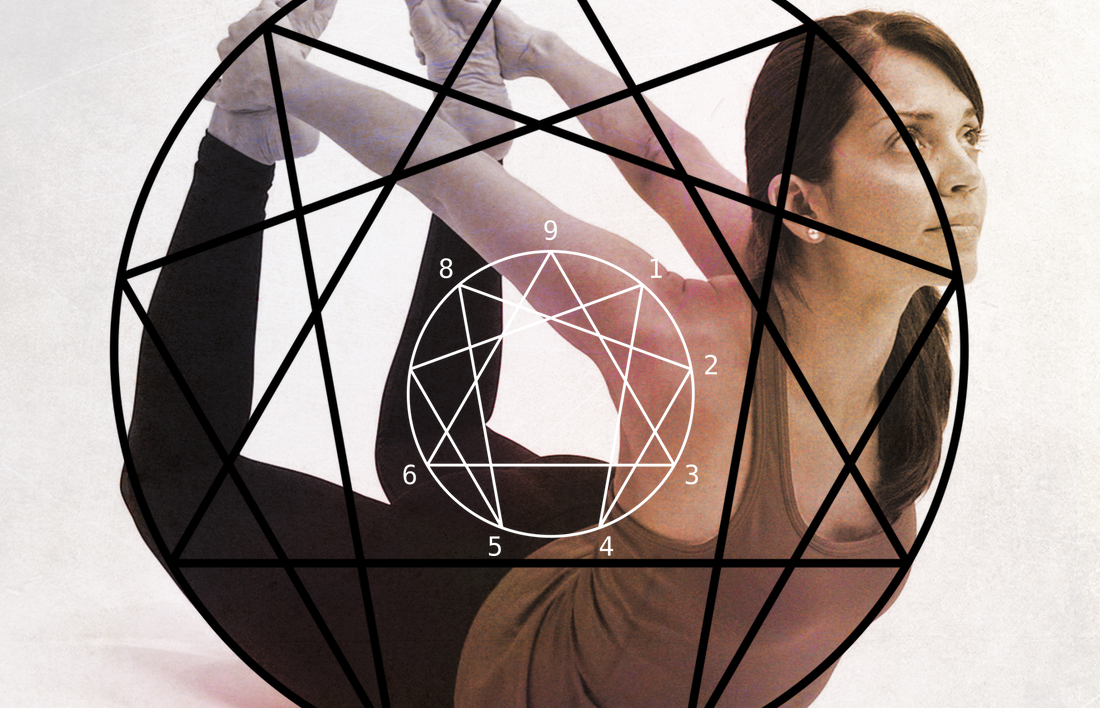The enneagram, a powerful tool for therapy and creativity used by counselors and artists alike, identifies personality characteristics through a system of nine interconnected points called enneatypes (also referred to as “types” or “patterns”). Each point corresponds to a specific set of traits that flavor an individual’s behavior patterns and outlook on the world. Although the enneagram exists in several contexts, ranging from the strictly clinical to the mystical, its usefulness as a means of self-discovery becomes even clearer when it’s paired with yoga practice.
The enneagram (from the Greek ennea – nine, and gramma – written or drawn) is a circular diagram made up of nine points linked by lines that connect each number to several others. It is broken up into three sections: the gut points (8, 9 and 1) lie at the top, the heart points (2, 3 and 4) are on the right, and the head points (5, 6 and 7) are on the left.
Unlike other personality analysis systems like the Myers-Briggs Type Indicator, the enneagram places a lot of importance on energy and embodiment, seeing the physical, emotional and spiritual bodies as one and the same. We each have characteristics of every point on the enneagram, but one point will predominate. The labels “gut,” “heart” and “head” thus correspond to how we take in and understand our environments on the deepest and most unconscious level of our being. As with yoga, the enneagram brings us into a full body awareness—and hopefully, acceptance—that has far-reaching impacts for how we move through the world.
People who are typed as “gut points” initially process information through that part of the body, feeling things very deeply in their core, intuiting situations and people on an instinctual level. While their energy often feels very earthy and grounded, people with these types often have issues around anger, which they may be able to manage effectively or not at all.
“Heart points” process information initially through their emotional centers. They can feel very deeply, whether or not they are aware of it. They prioritize connection with others and spend time crafting and projecting a particular image to the outside world, but have trouble with shame.
“Head points” are cerebral, processing information through the mind. Quick and intelligent, they prize knowledge and experience and spend time creating and planning ahead, but their mental alacrity is also linked to feelings of fear.
Each type has a particular way of moving through the world, and getting a handle on your own pattern can help you identify the traits—both healthy and unhealthy—that make you who you are. This process of discovery can also help you grow your yoga practice. Connecting the enneagram with certain yogic traditions can deepen the understanding of both systems. For instance, like the chakras, which correspond to the movement of energy in the body, the points on the enneagram correspond to stages of necessary growth or enlightenment, moving from root (the gut points) to third eye and crown (the head points). Each number is a piece of a whole puzzle that exists within every human being, but, as with the chakras, we might have more to work to do around a particular point if we’re looking to make certain changes in our lives.
In daily practice, using the enneagram can help us deepen our asana practice and create more balance in our bodies. Some heart points, for example, can be disconnected from their gut, their center of intuition and core strength. People with these patterns could really benefit from poses that strengthen the abdominals. Gut points might be more cut off from their heads, so poses like headstand might be a goal of practice. Head points might need more heart-opening poses to connect more fully with their emotional centers. Stay tuned for Part Two of this series to learn more about the connection between the points on the enneagram and your yoga practice, where we’ll offer specific postures, pranayama and practices to help you work with these areas of the body.
For now, if you don’t already know your type, spend some time thinking about which part of your body you process information through first. Do you walk into a room and immediately feel energy on a deep, core level (the gut points)? Do you feel your emotions first (the heart points)? Or do you think through the situation and process things mentally (the head points)? While teachers and students of the enneagram believe that a person’s type is fixed from birth, the system is far from limiting. The goal is not to pigeonhole individuals into a set of generalizations, but rather to identity type as a means to self-acceptance and empathic expansion. The end result of working with the enneagram is a deep realization of universal oneness. Like yoga, the enneagram helps you become your best self.
If you’re still unsure of your “type,” use your yoga practice to explore. Begin by noticing your breath. Where does your breath naturally travel in your body before you begin a specific pranayama? I you breathe more shallowly, you may be a head point. If you tend to pull your breath in deeply, your pattern might be in the gut triad. Bring this exploration into your next yoga practice. Simply noticing which poses you love versus which you dread can be useful in identifying your pattern.
If you are familiar with the enneagram, I’d love to hear from you! Have you used it as a tool in your own yoga practice?


















Leave a Reply